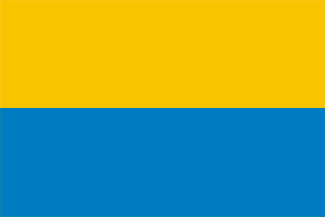
by Jaume Olle, 31 August 2001

Last modified: 2012-12-29 by andrew weeks
Keywords: ukraine | trident | jack | naval jack | border guard |
Links: FOTW homepage |
search |
disclaimer and copyright |
write us |
mirrors
see also:
In May, 1918 ukrainian navy officers Pokrovsky and Demenko
created the projects of navy flags:
- navy ensign - white with blue saltire (like navy ensign of
former Russian Empire, in that times this flag was abolished in
Russia by bolsheviks).
- jack - blue-yellow with gold 'seal of St.Volodimer' (trident)
- civil ensign - blue-yellow.
The flags were approved by contre-admiral Maximov.
In summer of 1918 new flags were designed. The flags were adopted
by hetman (head of state) P.Skoropadsky on 18, July, 1918.
- Navy ensign - white with blue cross (cross with thin white and
blue borders), national colours in canton, gold (bronze) trident
in the centre of canton. Ratio - unknown; width of the cross -
1/11 of flag-height; widths of blue and white borders - 1/8 of
width of the cross.
Source: V.Trembitsky, article in ukrainian bulletin
"Znak"
Victor Lomantsov, 27 December 2000
I can't read Ukranian, but the flag is described in french by
Philippe in a very good piece about ukranian flags, and also in
Banderas, and the double fimbriation of the cross is YELLOW and
BLUE instead White and Blue. Trident color is quoted as
black instead bronze.
Jaume Olle', 7 January 2001
No. The cross have WHITE and BLUE fimbriations. The trident is
gold (bronze) I have the original text of the Order of Navy
Minister of Ukraine Rogoza (1918) with detailed description of
the ensign. Yellow-blue fimbriation and black trident are
mistakes. Modern ukrainian Navy readopted the ensign of 1918
(with small changes). Now the fimbriation of ukrainian navy
ensign is blue-white too. Concering the images - the trident is
gold and the cross is thiner.
Victor Lomantsov, 7 January 2001 and 3 Febuary 2001
After the Revolution 1917, the time of anarchy and
demoralization came into former Russian Black Sea Fleet. The
Fleet, stationed in Sevastopol, was commanded by collective
"Centroflot". Diffefent political influences clashed:
Ukrainian, Bolshevist, Menshevist, Social-Revolutionary and
Anarchist. Very different flags were hoisted over ships:
Ukrainian bicolors, old Russian ensigns, Bolshevist red flags and
Anarchist black flags. They were hoisted and lowered even several
times daily, according to changes of each crew's political
orientation. Ukrainian People's Republic aspired to take control
over the Fleet. On 22 December 1917 the Naval Ministry in Kiev
was established. In April 1918 German troops invaded Crimea. On
29 April 1918 fleet-commanding Rear-admiral Sablin (Russian) gave
an order to hoist Ukrainian national flags over all ships in
Sevastopol. But Germans didn't accepted Ukraine's aspirations to
Crimea and Black Sea Fleet. They started to occupy Sevastopol.
Next day Sablin with part of fleet (including 2 dreadnoughts)
escaped to Novorossiysk and hoisted Russian St. Andrew (saltire)
ensigns. On 1 May 1918 Germans captured ships remaining in
Sevastopol. On 17 June 1918, after German ultimatum, 1
dreadnought and 6 destroyers returned from Novorossiysk to
Sevastopol, where were captured, too. Ships remained in
Novorossiysk were destroyed by own crews on Lenin's command. In
July-November 1918 Germans gradually transferred many ships under
command of Ukrainian government (Hetman Skoropadsky). On 18 July
1918 Naval Ministry in Kiev established new naval ensign and some
rank flags (e.g. flag of Naval Minister , flag of Deputy
Minister). Old Russian jack remained as Ukrainian naval jack. It
was regarded as symbol of glory of Black Sea Fleet, which crews
were in big part Ukrainian in past. In December 1918, when naval
forces of Ententa were approaching to Sevastopol, Ukrainian
Rear-admiral Klochovsky commanded all ships to hoist Russian St.
Andrew (saltire) ensigns. It was a demonstration of good
intentions for Ententa. However, the Black Sea Fleet was captured
by Ententa and subsequently transferred to Russian
"White" forces. Ukrainian naval authorities existed
until 1921.
Notice that the trident on naval flags in 1918 is not the
contemporary one, but is surmounted by cross. Images are
patterned after black-white drawings in Ukrainian magazine
"Litopys Chervonoi Kalyny" from 1932, and they may be
not fully correct.
Grzegorz Skrukwa, 3 Febuary 2001
According to http://www.uarmy.com.ua/ALMANAH/ALMANAH03/article12/art12.html
, the state flag of Ukrainian People`s Republic was used as navy
ensign before adoption of the January's ensign.
Victor Lomantsov, 6 July 2002
1) 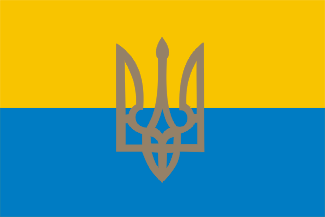
by Jaume Olle, 31 August 2001
2) 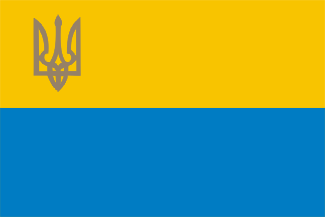
by Jaume Olle, 31 August 2001
3) 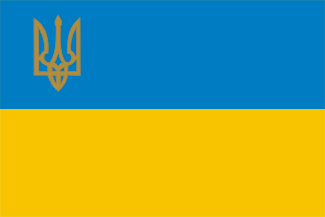
by Jaume Olle, 31 August 2001
4) 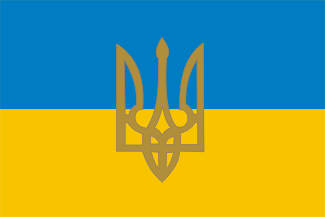
by Jaume Olle, 31 August 2001
On 18 (or 22?) January 1918 a naval ensign was adopted but
only hoisted on 29 April 1918. According to Kholevitsky the
trident was in the canton, but several sources say that trident
was in center. Also is reported reversion of colors for the flags
at sea (reversion in use after January 1918?). I dont know who is
correct so here is all possible versions for future discussion.
What is the exact size of the trident in both cases?
Jaume Olle, 31 August 2001
Version no. 2 appears at http://www.uarmy.com.ua/ALMANAH/ALMANAH03/article12/art12.html
as Navy Ensign of Ukrainian People`s Republic, adopted 18, Jan,
1918. However this is wrong: First navy ensign of Ukraine was
adopted by Law on 14, Jan. 1918.
Victor Lomantsov, 6 July 2002
Merchant ensign adopted 18 January 1918.
Jaume Olle, 31 August 2001
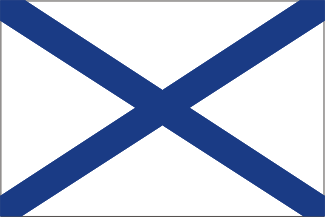
Naval Ensign
by Jaume Olle, 31 August 2001
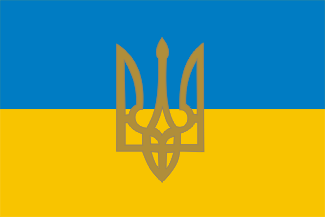
Naval Jack
by Jaume Olle, 31 August 2001
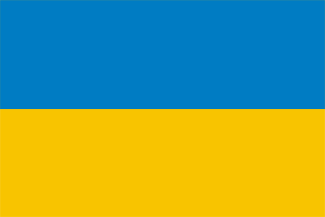
Civil Ensign
by Jaume Olle, 31 August 2001
In May, 1918 ukrainian navy officers Pokrovsky and Demenko
created the projects of navy flags:
- navy ensign - white with blue saltire (like navy ensign of
former Russian Empire, in that times this flag was abolished in
Russia by bolsheviks).
- jack - blue-yellow with gold 'seal of St.Volodimer' (trident)
- civil ensign - blue-yellow.
The flags were approved by contre-admiral Maximov.
Victor Lomantsov, 27 December 2000
The Jack and Civil ensign seems to be similar or equal to the
previous ones. I believe that reversion of colors was made de
facto in January 1918 but only regulated in 22 March 1918.
Jaume Olle, 31 August 2001